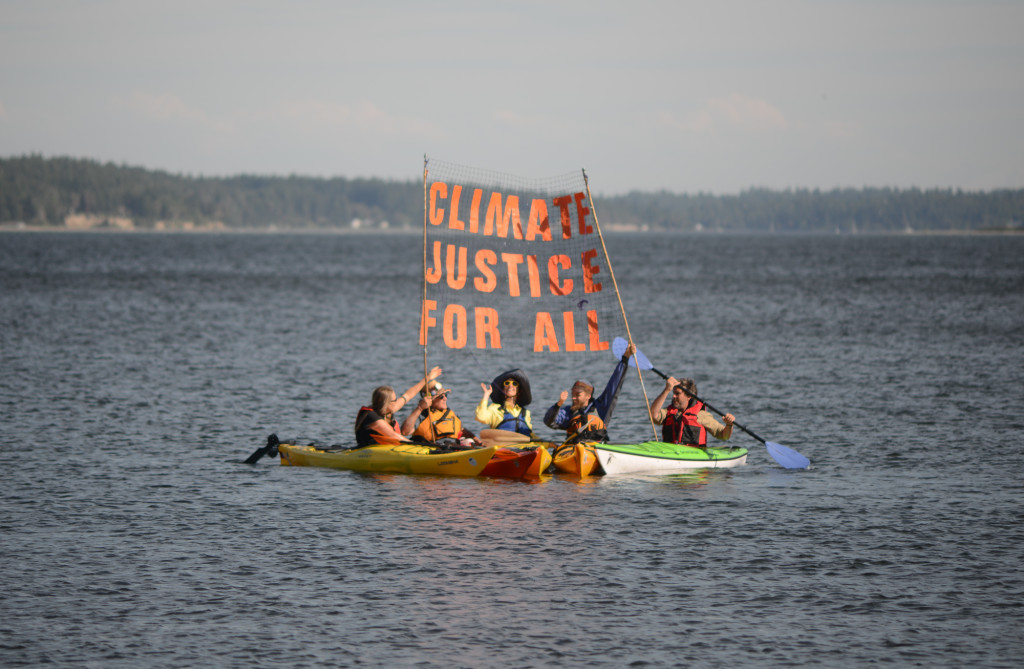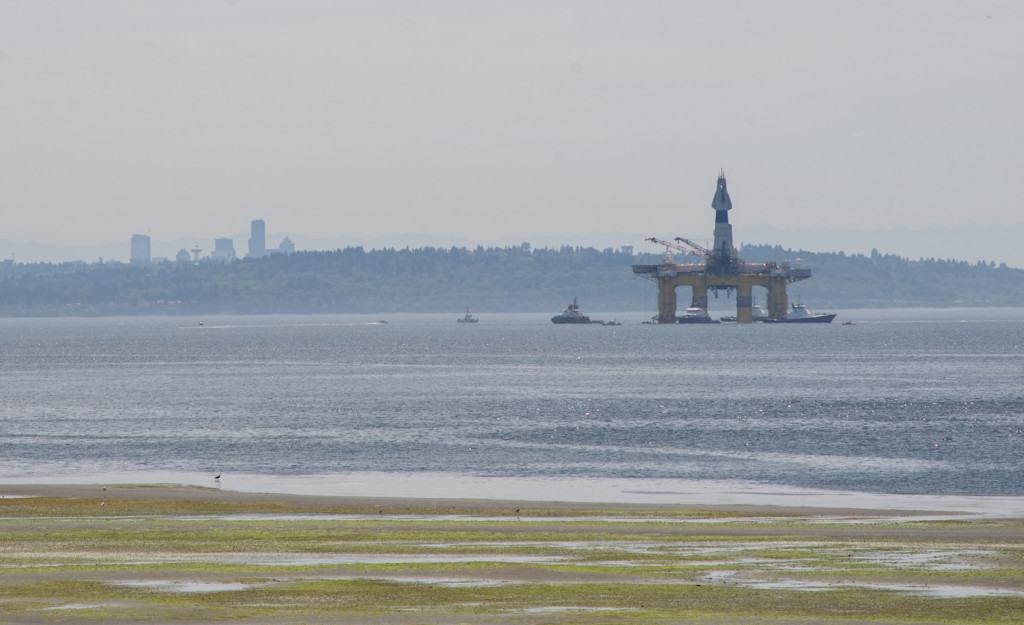Here in Seattle, we’ve been participating in and supporting the #sHellNO actions against the Arctic Drilling rig, Polar Pioneer, that has been parked at the Port of Seattle for weeks. As of yesterday morning, the rig is finally on the move, heading north on it’s way to the Arctic. Two dozen kayakers were detained and cited yesterday for attempting to interdict the rig, adding to the tally of arrests and fines incurred in the direct action.
Opposition to the rig has been widespread. Seattle city councilmember Mike O’Brien was among those arrested yesterday morning. A group of grandmothers was arrested a few days ago for blockading the land access to the terminal. The issue has received international media coverage, and support from just about every environmentalist and enviro-group you can imagine. Protests have been almost continuous for weeks. We have never seen such a flourishing of resistance in a short period.

Towing kayaks towards the shipping channel on June 15th in an attempt to block the rig. We were turned back by 4-foot swells that flipped the boats soon after this photo was taken.
And yet, this morning, the rig is on the move, protected by police and coast guard working diligently on behalf of profit and destroying the planet (in short, working on behalf of the law). Unless blockades further north are more successful, or a major policy change is implemented, the rig will reach Arctic waters in a few weeks and begin its murderous work.
It is likely that, despite everything we have poured into this campaign, it will fail.
And, of course, this one campaign addresses only a fraction of fossil fuel extraction globally. Our members and allies have been on water, blocking the rigs and fighting as hard as possible to stop the Polar Pioneer. But thus far, we have failed.
What do we do when mass movements fail?
We want this movement to be successful. A ban on Arctic Drilling would be a smart, feasible policy change. As the great feminist lawyer Catherine McKinnon said, “Law organizes power.” It makes sense for activists and concerned people to use law, community organizing, and mass movements to take power away from those who would destroy the planet.
But far too often, that strategy doesn’t work. It’s not working now.
We need a new strategy for a movement that has too long been on the defensive. We need a war cry for a people who refuse to lose any more battles, the last resort of a movement isolated, co-opted, and weary from never-ending legal battles and blockades. Such a strategy exists, and it is written for those who understand that we live in the midst of a war against the planet. It’s time we turned the tide.
Turning the Tide
If we want to win, we need new strategies and tactics. It’s not enough to keep doing what we have been doing for years and decades, hoping that *this time*, finally, enough people join the movement to make it effective – hoping that this time, the president will be forced to do something. Sure, we have occasional victories. But by and large, our movement is losing, and contrary to popular belief, green technology won’t save us.
To turn the tide, we believe in direct resistance — but a smarter, more strategic, more decisive resistance that doesn’t bother trying to convince the masses or petition the government (although these methods are still important, and should be pursued in parallel). Instead, this strategy advocates for the formation of highly organized clandestine groups to take the onus of resistance, sabotaging critical nodes of industrial infrastructure to cut the arteries of global capitalism.
The information in this strategy is derived from military strategy and tactics manuals, analysis of historic resistances, insurgencies, and national liberation movements. The principles laid out within these pages are accepted around the world as sound principles of asymmetric conflict, where one party is more powerful than the other. If any fight was ever asymmetric, this one is. These strategies and tactics are taught to military officers at places like the Military Academy at West Point for a simple reason: they are extremely effective.
When he was on trial in South Africa in 1964 for his crimes against the apartheid regime, Nelson Mandela said: “I do not deny that I planned sabotage. I did not do this in a spirit of recklessness. I planned it as a result of a long and sober assessment of the political situation after many years of oppression of my people by the whites.” We invite you to read this strategy, and to undertake that same long and sober assessment of the situation we face. Time is short.
Read the strategy: Decisive Ecological Warfare
(in English, Russian, French, or Portuguese)




Thank you for this – I will read it.